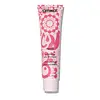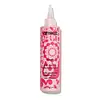What's inside
What's inside
 Key Ingredients
Key Ingredients

 Benefits
Benefits

 Concerns
Concerns

 Ingredients Side-by-side
Ingredients Side-by-side

Water
Skin ConditioningMaris Sal
Skin ConditioningDisodium Laureth Sulfosuccinate
CleansingCocamide Methyl Mea
Lauryl Betaine
CleansingParfum
MaskingTropaeolum Majus Flower/Leaf/Stem Extract
Skin ConditioningTocopheryl Acetate
AntioxidantSalicylic Acid
MaskingHippophae Rhamnoides Seed Oil
Skin ProtectingKaolin
AbrasiveCharcoal Powder
AbrasiveGlycerin
HumectantPolyquaternium-7
Sodium Benzoate
MaskingCitric Acid
BufferingSodium Phytate
Sodium Chloride
MaskingPhenoxyethanol
PreservativeEthylhexylglycerin
Skin ConditioningButylphenyl Methylpropional
PerfumingHydroxycitronellal
PerfumingHydroxyisohexyl 3-Cyclohexene Carboxaldehyde
MaskingLimonene
PerfumingWater, Maris Sal, Disodium Laureth Sulfosuccinate, Cocamide Methyl Mea, Lauryl Betaine, Parfum, Tropaeolum Majus Flower/Leaf/Stem Extract, Tocopheryl Acetate, Salicylic Acid, Hippophae Rhamnoides Seed Oil, Kaolin, Charcoal Powder, Glycerin, Polyquaternium-7, Sodium Benzoate, Citric Acid, Sodium Phytate, Sodium Chloride, Phenoxyethanol, Ethylhexylglycerin, Butylphenyl Methylpropional, Hydroxycitronellal, Hydroxyisohexyl 3-Cyclohexene Carboxaldehyde, Limonene
Water
Skin ConditioningPolysorbate 20
EmulsifyingGlycerin
HumectantCocamidopropyl Betaine
CleansingSodium Cocoyl Isethionate
CleansingSodium Lauroyl Oat Amino Acids
CleansingAcrylates/Beheneth-25 Methacrylate Copolymer
Menthyl Lactate
MaskingTropaeolum Majus Flower/Leaf/Stem Extract
Skin ConditioningHippophae Rhamnoides Oil
EmollientHelianthus Annuus Seed Oil
EmollientCharcoal Powder
AbrasiveMontmorillonite
AbsorbentAloe Barbadensis Leaf Extract
EmollientApium Graveolens Seed Extract
AntioxidantCalendula Officinalis Flower Extract
MaskingCoccinia Indica Fruit Extract
Skin ConditioningCorallina Officinalis Extract
Skin ConditioningMelia Azadirachta Flower Extract
Skin ConditioningMelia Azadirachta Leaf Extract
Skin ConditioningRosmarinus Officinalis Leaf Extract
AntimicrobialMenthol
MaskingMenthone Glycerin Acetal
RefreshingCaprylic/Capric Triglyceride
MaskingCaprylyl Glycol
EmollientEthylhexylglycerin
Skin ConditioningHexylene Glycol
EmulsifyingPhenoxyethanol
PreservativePotassium Sorbate
PreservativeSodium Hydroxide
BufferingParfum
MaskingTetrasodium EDTA
Butylphenyl Methylpropional
PerfumingLimonene
PerfumingWater, Polysorbate 20, Glycerin, Cocamidopropyl Betaine, Sodium Cocoyl Isethionate, Sodium Lauroyl Oat Amino Acids, Acrylates/Beheneth-25 Methacrylate Copolymer, Menthyl Lactate, Tropaeolum Majus Flower/Leaf/Stem Extract, Hippophae Rhamnoides Oil, Helianthus Annuus Seed Oil, Charcoal Powder, Montmorillonite, Aloe Barbadensis Leaf Extract, Apium Graveolens Seed Extract, Calendula Officinalis Flower Extract, Coccinia Indica Fruit Extract, Corallina Officinalis Extract, Melia Azadirachta Flower Extract, Melia Azadirachta Leaf Extract, Rosmarinus Officinalis Leaf Extract, Menthol, Menthone Glycerin Acetal, Caprylic/Capric Triglyceride, Caprylyl Glycol, Ethylhexylglycerin, Hexylene Glycol, Phenoxyethanol, Potassium Sorbate, Sodium Hydroxide, Parfum, Tetrasodium EDTA, Butylphenyl Methylpropional, Limonene
 Reviews
Reviews

Alternatives
Ingredients Explained
These ingredients are found in both products.
Ingredients higher up in an ingredient list are typically present in a larger amount.
Butylphenyl Methylpropional is a synthetic fragrance. You might know it as "lilial". The scent of this ingredient is floral-like and similar to the scent of lily flowers.
In March of 2022, the EU banned this ingredient in both rinse-off and leave-on products. This is because research found Butylphenyl Methylpropional to disrupt fertility in rats.
This ingredient is also a known EU allergen, meaning it is likely to cause an allergic reaction. Irritated skin can be damaging.
We always recommend speaking with a professional if you have any concerns or questions about this ingredient.
Learn more about Butylphenyl MethylpropionalCharcoal powder comes from grounded charcoal. Charcoal can originate from peat, bamboo, coal, wood, coconut shell, or petroleum.
This ingredient has absorbent properties, making it great at absorbing oil.
Ethylhexylglycerin (we can't pronounce this either) is commonly used as a preservative and skin softener. It is derived from glyceryl.
You might see Ethylhexylglycerin often paired with other preservatives such as phenoxyethanol. Ethylhexylglycerin has been found to increase the effectiveness of these other preservatives.
Glycerin is already naturally found in your skin. It helps moisturize and protect your skin.
A study from 2016 found glycerin to be more effective as a humectant than AHAs and hyaluronic acid.
As a humectant, it helps the skin stay hydrated by pulling moisture to your skin. The low molecular weight of glycerin allows it to pull moisture into the deeper layers of your skin.
Hydrated skin improves your skin barrier; Your skin barrier helps protect against irritants and bacteria.
Glycerin has also been found to have antimicrobial and antiviral properties. Due to these properties, glycerin is often used in wound and burn treatments.
In cosmetics, glycerin is usually derived from plants such as soybean or palm. However, it can also be sourced from animals, such as tallow or animal fat.
This ingredient is organic, colorless, odorless, and non-toxic.
Glycerin is the name for this ingredient in American English. British English uses Glycerol/Glycerine.
Learn more about GlycerinLimonene is a fragrance that adds scent and taste to a formulation.
It's found in the peel oil of citrus fruits and other plants such as lavender and eucalyptus. The scent of limonene is generally described as "sweet citrus".
Limonene acts as an antioxidant, meaning it helps neutralize free radicals.
When exposed to air, oxidized limonene may sensitize the skin. Because of this, limonene is often avoided by people with sensitive skin.
The term 'fragrance' is not regulated in many countries. In many cases, it is up to the brand to define this term. For instance, many brands choose to label themselves as "fragrance-free" because they are not using synthetic fragrances. However, their products may still contain ingredients such as essential oils that are considered a fragrance.
Learn more about LimoneneParfum is a catch-all term for an ingredient or more that is used to give a scent to products.
Also called "fragrance", this ingredient can be a blend of hundreds of chemicals or plant oils. This means every product with "fragrance" or "parfum" in the ingredients list is a different mixture.
For instance, Habanolide is a proprietary trade name for a specific aroma chemical. When used as a fragrance ingredient in cosmetics, most aroma chemicals fall under the broad labeling category of “FRAGRANCE” or “PARFUM” according to EU and US regulations.
The term 'parfum' or 'fragrance' is not regulated in many countries. In many cases, it is up to the brand to define this term.
For instance, many brands choose to label themselves as "fragrance-free" because they are not using synthetic fragrances. However, their products may still contain ingredients such as essential oils that are considered a fragrance by INCI standards.
One example is Calendula flower extract. Calendula is an essential oil that still imparts a scent or 'fragrance'.
Depending on the blend, the ingredients in the mixture can cause allergies and sensitivities on the skin. Some ingredients that are known EU allergens include linalool and citronellol.
Parfum can also be used to mask or cover an unpleasant scent.
The bottom line is: not all fragrances/parfum/ingredients are created equally. If you are worried about fragrances, we recommend taking a closer look at an ingredient. And of course, we always recommend speaking with a professional.
Learn more about ParfumPhenoxyethanol is a preservative that has germicide, antimicrobial, and aromatic properties. Studies show that phenoxyethanol can prevent microbial growth. By itself, it has a scent that is similar to that of a rose.
It's often used in formulations along with Caprylyl Glycol to preserve the shelf life of products.
We don't have a description for Tropaeolum Majus Flower/Leaf/Stem Extract yet.
Water. It's the most common cosmetic ingredient of all. You'll usually see it at the top of ingredient lists, meaning that it makes up the largest part of the product.
So why is it so popular? Water most often acts as a solvent - this means that it helps dissolve other ingredients into the formulation.
You'll also recognize water as that liquid we all need to stay alive. If you see this, drink a glass of water. Stay hydrated!
Learn more about Water